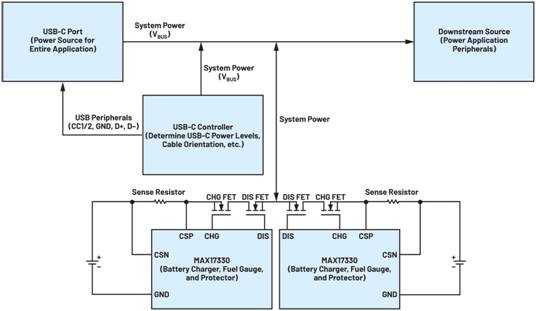How to use USB-C to achieve parallel battery charging to help improve user experience

|
Single cable |
Power and data are on the same cable, which is beneficial in space constrained applications |
|
High power levels |
Increased capacity and higher charging levels allow for a larger range of possible applications, including both low power consumer devices and high power tools and computers |
|
Time saver |
The high charge current capabilities of USB-C allow for charging batteries in parallel, which results in more usable capacity in the amount of time it takes to charge just one battery |
|
Simple integration |
USB-C cable is reversible and can be plugged in either way, while adding additional batteries in parallel simply requires connecting the power source to the terminals of the new battery |
|
Reduced electronic waste over time |
Using a common USB-C charger for multiple devices would reduce electronic waste around the world |
|
Differences in ports |
Complications over power levels can occur if both ports do not match. The multiple ports include Thunderbolt, Power Delivery 3.1, and Power Delivery 3.0 |
|
More expensive |
Additional batteries along with ports and cables that allow for faster charging require advanced technology, which is more expensive than previous versions |
|
Cable replacement |
New USB-C cables will force USB-A, USB-B, and micro-USB cables to be replaced and the older cables will become obsolete |
|
Larger size |
dding an additional battery is going to take up extra space, which can become an issue in applications where size is a critical specification |
|
Increased complexity |
Including an additional battery introduces a few complex issues, such as the need to balance aging across the batteries and ensuring charge cycles begin at similar voltages so the batteries or wiring is not damaged |
Example of using MAX17330
Figure 2 shows one of the main tools required to create a parallel battery charging environment - an example of MAX17330. The product IC integrates a battery charger, battery meter, and protector. The MAX17330 receives power from a USB-C compatible charger or converter, and then charges parallel battery packs at high speed to maximize the user‘s usage time. In addition, this configuration allows the battery to be placed in special positions, such as on the other side of AR/VR headphones or on different sides of foldable phones. Some benefits of using this chip include the ability to fully reduce pressure difference and heat, prevent cross charging of parallel batteries, and the ability to independently charge parallel battery packs.
Practical Application of MAX17330
This article introduces the combination of parallel battery charging and USB-C, and points out some advantages and disadvantages. Now that we have a better understanding of the entire theme, it is necessary to look at some practical applications. Parallel battery charging and USB-C have begun to enter some consumer markets. This includes but is not limited to tools such as AR/VR headphones, cordless drills, laptops, and portable tablets. The challenges mentioned in Table 2 above have brought some difficulties to designers in designing such systems. Replace the module in Figure 2 with ADI‘s MAX17330, replace the USB-C controller with MAX77958, and replace the downstream power supply with MAX77986. With the help of MAX77958, designers can simplify design through independent solutions and customized firmware, which determine the power supply level of USB-C, while MAX77986 can serve as the downstream power supply for USB-C, supplying power to other parts of the entire product. This type of setting is very suitable for applications with power requirements of 15 W or above. For power applications below 15 W, the MAX77789 is the ideal choice, combining the 1S 3A charger with the USB-C detection function. To verify the functionality of these products, you can click here to order the MAX17330 evaluation kit or click here to order the MAX77789 evaluation kit. If you want to obtain samples of MAX17330 for prototype production, please visit the sample application website. For more information about MAX17330, please watch "Introduction to MAX17330".

Figure 2. Block diagram of parallel battery charging environment with integrated MAX17330
conclusion
In today‘s world, consumers hope to use products with maximum efficiency and do not want to waste any time. All of ADI‘s products can be used in combination, supporting consumers to combine the fast charging function of USB-C with parallel battery packs. This helps to extend the battery life of the final product, shorten charging time, and thus improve efficiency. With the continuous development of the consumer market, designers need to adapt quickly and try their best to meet customer needs. When searching for new charging methods for the next generation of consumer electronic devices, facing constantly changing problems, USB-C and parallel battery charging will be a good solution.
|
Disclaimer: This article is transferred from other platforms and does not represent the views and positions of this site. If there is any infringement or objection, please contact us to delete it. thank you! |











